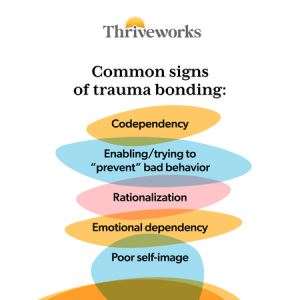Trauma can have a variety of impacts on survivors, and each is often intense in its own way. One such impact traumatic experiences can have is called a “trauma bond.” Trauma bonding is a strong connection that occurs between victims/survivors and perpetrators of trauma or abuse.
These bonds are complex and intense, and it will often take receiving help from a mental health professional to fully process and heal from the relationship. Read on to learn more about what trauma bonding is and how it impacts mental health.
What Is Trauma Bonding?
Trauma bonding occurs when a traumatic event(s) creates a close tie or bond between the person who experienced the trauma and the perpetrator of the event. This often occurs in situations of abuse or, again, a traumatic experience caused or enacted by a specific perpetrator.
“Trauma bond” is also used colloquially to mean attachment between people who went through trauma together or have experienced similar types of trauma, though that’s not the true definition of the term. This idea is similar to drama bonding, or the idea of connecting with another person through shared outrage or conflict.
Trauma bonds between victim and perpetrator can be dangerous and may lead people who are being abused to stay with their abuser, even when the situation is not safe.
What Is a Trauma-Bonded Relationship?
A trauma-bonded relationship refers to high-conflict or abusive relationships in which two people — the person experiencing abuse or trauma and the person perpetrating it — become bonded through difficult and complex traumatic events. These shared experiences result in a certain closeness, even when one or both parties recognize the toxicity of what’s happening.
Trauma bonds develop when relationships have high amounts of manipulation and confusion. This dynamic is often created by cycles of abusive behavior from the perpetrator followed by love-bombing and/or apologies.
Because the connection between two people in a trauma-bonded relationship can be so intense, other relationships might feel less intense in a negative way. The intensity can feel meaningful, like the two of you share a unique bond that other people wouldn’t understand. By comparison, it may seem like other relationships have less passion or love when, in reality, they may just be more stable and healthy.
In this situation, the person being abused and/or manipulated may also tend to focus on the good behavior the perpetrator displays rather than the bad or abusive behavior they exhibit.
This dynamic can occur within any relationship, including partners or parent/child relationships.
Signs and Symptoms of Trauma Bonding
Common signs of trauma bonding are:
- Codependency
- Enabling, trying to “prevent” bad behavior (victim walks on eggshells)
- Excuses, minimizing, and/or rationalization (can isolate victim from others who see issues while intensifying bond with perpetrator)
- Enmeshment (victim becomes emotionally dependent on perpetrator and loses sight of oneself)
- Poor self-image/self-esteem
It’s also important to note that when this dynamic develops during childhood, it can become “normal” and influence the way one sees relationships and relationship dynamics in the future.

What Are the 7 Stages of Trauma Bonding?
The seven stages of trauma bonding are:
- Love bombing: Perpetrators of abuse may often “love bomb,” or be excessively kind and generous (e.g. buying gifts, giving compliments, being incredibly thoughtful) at the beginning of a relationship to establish trust and gratitude that can be manipulated later on.
- Developing trust and dependency: In this stage, the perpetrator works to establish trust with their victim, often doing so much for them that the victim becomes financially or emotionally dependent on them.
- Criticism: Perpetrators will steadily become more critical of their victim, slowly breaking down their self-esteem.
- Gaslighting: Gaslighting allows perpetrators to cut their victim off from other trusted people and may make the victim believe they can’t or shouldn’t reach out to others. (“No one will believe you,” “they wouldn’t understand,” etc.)
- Emotional addiction: Due to the relationship’s volatility and inconsistency, victims may become emotionally dependent on the perpetrator. Perpetrators can also become trauma-bonded to their victims — they may feel true regret for harming and/or traumatizing their victim but lack the tools to manage their intense emotions.
- Loss of self: Once a victim becomes emotionally dependent or “addicted” to the perpetrator, their life starts to revolve around making the perpetrator happy and avoiding abusive outbursts. Victims often lose sight of their own wants, needs, and desires, eventually becoming unable to extricate who they are from the demands of their trauma-bonded relationship.
- Resignation: Over time, victims may come to accept the perpetrator’s behavior as what they “deserve” and submit to the actions of the perpetrator. Manipulation, the intensity of the bond, and the conditionality of the perpetrator’s good behavior often contribute to the feeling that the relationship is right, despite its major flaws.
These stages do not occur in every instance of trauma bonding. Whether one or both parties in the relationship are trauma-bonded, each abusive or manipulative relationship is different and the events leading to the trauma-bond will impact the relationship in a unique way.
How Do You Break Trauma Bonds?
Two of the main things needed to break trauma bonds are immense support and help from a mental health professional. As stated above, these relationships are very complex and have intense emotions tied to them, meaning it’s incredibly difficult to see the relationship’s full impact and influence on one’s life without an outside perspective.
To fully understand what’s happening, individuals need insight into themselves and their relationships. A mental health professional can help them work on themselves by exploring early childhood experiences that could have influenced their current relationships and slowly breaking patterns of enmeshment and codependency. This can go for both survivors and perpetrators of abuse.
However, the most important factor is individual safety. If an individual is not physically safe, getting a safe and independent space is the first priority. They’ll need to plan for this change (which may include a plan for kids or pets as well), whether they use their own savings or money or get support from others during this time. If you need help and do not feel safe in your current situation, the National Domestic Violence Hotline can offer you resources and assistance.
How Long Does a Trauma Bond Last?
The duration of a trauma bond or trauma-bonded relationship depends on the relationship. Getting out of a trauma bond can require a lot of untangling, and often requires leaving and spending time away from the other person in the relationship.
Trauma bonding goes well beyond the common levels of conflict in relationships, which is why trauma-bonded relationships are often not salvageable. Without spending time apart and being out of contact with the other person, it can be challenging for someone to get out of the trauma-bond cycle.
Do Narcissists Feel Trauma-Bonded?
It is possible for narcissists and people with narcissistic personality disorder (NPD) to feel trauma-bonded — either on the side of the perpetrator or the victim.
Trauma bonds will often go both ways, as the perpetrator can regret abusing their victim and may not know how to fix what they’ve done. This dynamic can mean the perpetrator needs the other person in the relationship as much as the other needs them.
However, narcissists and people with narcissistic personality disorder both struggle with empathizing with others and therefore may not feel trauma-bonded to a person they are mistreating or abusing, since they may not feel regret or shame due to their abusive action.
What Does a Trauma Bond With a Narcissist Look Like?
Trauma bonds with narcissists will likely look the same as any trauma bond, depending on patterns, the caliber of abuse, and the type or closeness of the relationship when it began.
Again, though, to create a trauma “bond,” there needs to be connection and an attempt(s) to repair the relationship after mistreatment. Many of the symptoms of NPD are directly contradictory to these requirements — for example, a strong lack of empathy.
What Are the Effects of Trauma Bonding on Mental Health?
Trauma bonds can have many adverse effects on mental health, including:
- Making people confused about their relationships, emotions, and selves
- Depression
- Anxiety
- Emotional volatility
- Skewed sense of self
- Poor self-image
- Feeling isolated or alone, like no one can understand you
Trauma bonds can greatly impact the way someone sees themselves. The perpetrator’s emotional volatility and changeability can cause victims and survivors to crave safety. Because of this, they may seek the familiarity of their relationship with the perpetrator, rather than true safety. They can also feel like they are the cause of the perpetrator’s behavior, leading them to believe they are “bad” or “unworthy” of real love due to their perceived mistakes.
Perpetrators within trauma-bonded dynamics often don’t know how to handle their big feelings, and though it can seem like accepting their behavior could be healing, it actually doesn’t require them to learn how to manage their emotions, which in turn enables the behavior and continues to cause the perpetrator stress.
Coping Strategies for Unraveling Trauma Bonds
One of the best things to do when breaking from a trauma-bonded relationship is to focus on yourself.
Take care of yourself by dedicating the energy you were giving to your relationship to other things, like:
- Therapy
- Medication (possibly)
- Establishing a sleep schedule
- Meditation
- Exercise
It’s also important to maintain awareness of the trauma-bonded dynamic, since you will likely want to seek safety due to the stress of breaking from the trauma bond. You may feel the instinct to seek safety from the other person in the relationship, but keep in mind that the person isn’t actually safe. This is why it’s important to maintain distance and put yourself in a different environment.
However, the most influential and effective thing you can do for yourself is to seek help from a mental health therapist and go to therapy. Dialectical behavioral therapy (DBT) teaches distress tolerance skills that can be beneficial in these situations, so you may want to look for a therapist who specializes in it.
Again, if you do not feel safe breaking from a trauma-bonded relationship, the National Domestic Violence Hotline has resources to help and protect people in violent and abusive relationships.













